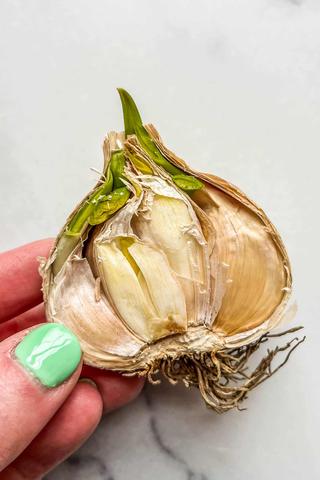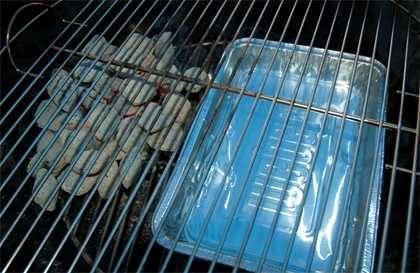
“Browning Spots on Garlic: Causes, Prevention, and Remedies” – Discover the reasons behind those unsightly brown spots on your garlic bulbs, and learn effective ways to prevent their occurrence. From storage tips to natural remedies, this comprehensive guide will help you keep your garlic fresh and spot-free.”
What Are The Brown Spots on Garlic?
The brown spots on garlic are not mold, but rather the result of bulb mites eating away at the garlic. These tiny mites leave scars in the garlic, causing small raised patches that are medium to dark brown in color. While these spots may resemble mold, they are harmless and do not indicate that the garlic has gone bad.

If you prefer to remove the bulb mites from the garlic before consuming it, there are simple methods you can use. One method is to soak the garlic bulbs in water that is at least 130 degrees Fahrenheit for 10 minutes. Afterward, you can peel away the affected layers, eliminating most of the mites and their eggs.
It’s important to note that while garlic with brown spots is safe to eat, it may have a quicker deterioration rate and a slightly altered flavor compared to fresh garlic. Therefore, it’s best to avoid purchasing garlic that is infested with bulb mites.
Should Garlic Have Brown Spots?
It is common to find brown spots on garlic, but this does not necessarily mean that the garlic has gone bad. Brown spots on garlic are usually the result of bulb mites eating away at the garlic. These small mites leave scars on the garlic, causing raised brown patches. However, these mites are not dangerous and the garlic is still safe to consume. If you prefer to remove the bulb mites before preparing the garlic, there are simple methods such as soaking it in hot water and peeling away the affected layers.
While brown spots may be offputting, they do not indicate that the garlic has gone bad. The brown patches are just a cosmetic issue caused by bulb mites and do not affect the safety or flavor of the garlic. It is important to differentiate between these harmless spots and other signs of spoilage such as rotten patches or a rancid scent. If you notice any of these signs, it is best to discard the garlic as it may cause foodborne illness.
To store your garlic properly and prevent mold growth or sprouting, it should be kept in a cool, dry place with good air circulation. Storing it in a mesh container or freezing it can help prolong its shelf life. Overall, while brown spots may not look appetizing, they do not pose any health risks and should not deter you from enjoying the delicious flavor of garlic.
Is It Still Safe to Eat?
If you notice brown spots on garlic cloves, don’t worry – it’s not necessarily mold. These brown spots are actually scars left by bulb mites, tiny insects that eat away at the garlic. While the appearance may be concerning, rest assured that the garlic is still safe to consume. The bulb mites themselves are not dangerous, and with a simple method of removing the outer layers of skin, you can get rid of most of the mites before preparing the garlic.
However, it is best to avoid garlic that is heavily infested with bulb mites as it can deteriorate faster and lose its flavor. If you happen to purchase garlic with bulb mites, there are ways to kill them off and prevent further damage. One method is soaking the bulbs in water at least 130 degrees Fahrenheit for 10 minutes, which should kill off the mites and their eggs. Additionally, it’s important to be aware of other signs that indicate garlic has gone bad, such as rotten patches or a rancid scent. Eating spoiled garlic can lead to foodborne illness.
How to Know if Garlic Is Bad

When inspecting garlic, it is important to differentiate between harmless brown spots caused by bulb mites and signs of spoilage or contamination. Brown spots on garlic are raised patches resulting from bulb mite activity and are safe to consume. However, if the garlic has gone bad, there are noticeable indicators to look out for.
Rotten patches on garlic cloves appear brown or black and have a soft texture. If these patches are present, it is recommended to discard the garlic as consuming it may lead to foodborne illness. Additionally, if the peeled cloves have a yellow hue or show more signs of decay, it is best not to consume them.
The presence of green roots on garlic cloves signifies that sprouting has occurred. While sprouted garlic is safe to eat, some individuals find its flavor sharper than usual. Alternatively, sprouted garlic can be planted for future use. Smelling the garlic can also provide insight into its freshness; a fresh garlic bulb should have a strong aroma. If the smell is less robust or has turned musty or rancid, it indicates that the garlic has begun to rot and should be discarded.
Look for Visual Signs
When examining garlic, it is important to pay attention to visual signs that indicate its quality and safety. One common visual sign to look out for is the presence of raised brown patches on the cloves. These patches, often mistaken for mold, are actually scars caused by bulb mites feeding on the garlic. While these scars may be offputting, they do not pose any harm and the garlic can still be consumed safely.
Additionally, be cautious of any rotten patches on the garlic. Rotten patches are usually brown or black in color and have a soft texture. If you come across such patches, it is advisable to discard the garlic as consuming it may lead to foodborne illness. Similarly, if you notice a yellow hue or more bad spots on the clove itself, it is best to dispose of the garlic.
An indication that your garlic has started to sprout is the presence of green roots on the cloves. While sprouted garlic is still safe to consume, some people find its flavor sharper than usual. Alternatively, you can opt to plant sprouted garlic and enjoy fresh cloves in the future.
Look for Green Roots
If you notice green roots on your garlic cloves this means that the garlic has begun to sprout. There is nothing wrong with eating garlic that has sprouted, although some people do not like the flavor of sprouted garlic as it is sharper than usual. If you decide not to eat your sprouted garlic you can always plant it. Then, by the next year, you will have new cloves of garlic that you and your family can enjoy.
Smell It
One way to check if your garlic has gone bad is by smelling it. Normally, garlic will have a fresh, clean smell and smell very strongly of garlic. However, if the garlic scent is not as robust as usual, it could mean that the garlic is losing its flavor and beginning to go bad. If the garlic smells musty or rancid, then it has definitely begun to rot and you should throw it out. It’s important not to risk eating garlic that has begun to rot as it could make you very sick.
How to Properly Store Garlic

To ensure that your garlic stays fresh and flavorful, it is important to store it properly. The ideal storage location for garlic is a cool, dry place away from direct sunlight. Your pantry is usually the best spot for storing garlic. Avoid storing garlic in warm areas as this can promote mold growth, and refrain from keeping it in the refrigerator as it may cause the garlic to sprout.
When storing garlic, make sure to provide adequate air circulation. Mesh containers are ideal for storing garlic as they allow for airflow between the bulbs and prevent moisture buildup, reducing the risk of mold. Avoid using sealed plastic bags or containers that trap moisture.
If you anticipate needing to store garlic for an extended period, freezing can be a viable option. Freeze whole cloves in an airtight freezer bag to prevent moisture loss and freezer burn.
Conclusion
In conclusion, brown spots on garlic are not a cause for concern. These spots are the result of bulb mites eating away at the garlic, leaving small raised patches of scarring. However, these mites are not dangerous and the garlic is still safe to consume. If you prefer to remove the bulb mites, there are simple methods such as soaking the bulbs in hot water or peeling away the affected layers.
It is important to be aware of other signs that indicate garlic has gone bad, such as rotten patches or a rancid smell. Eating spoiled garlic can lead to foodborne illness and should be avoided. Storing garlic in a cool, dry place and providing ample air circulation can help prevent mold growth and prolong its shelf life.
In summary, while brown spots on garlic may be unappealing, they do not indicate spoilage or pose any health risks. With proper storage and attention to signs of deterioration, garlic can continue to be enjoyed for its fantastic flavor and culinary benefits.
In conclusion, brown spots on garlic can be caused by various factors such as fungal infections, physical damage, or natural aging of the bulbs. While these spots are generally harmless and do not affect the overall quality or taste of the garlic, it is recommended to remove them before consumption to ensure optimal freshness. Regular inspection and proper storage can help prevent the development of brown spots, ensuring a longer shelf life for your garlic.
Learn More About Grilling
If you want to learn more about grilling, check out these other helpful resources!











